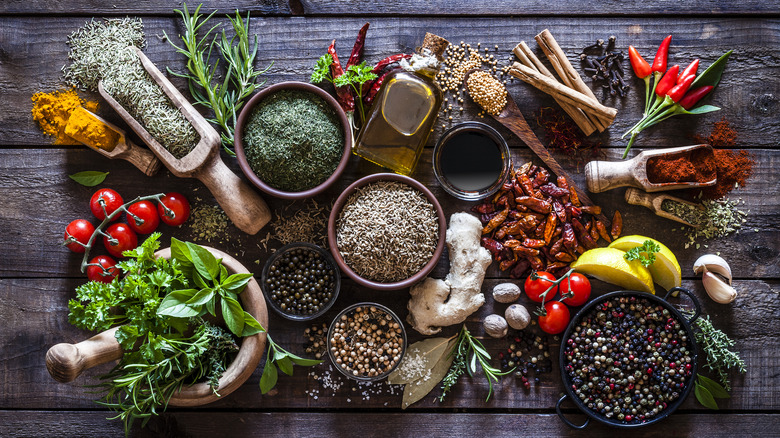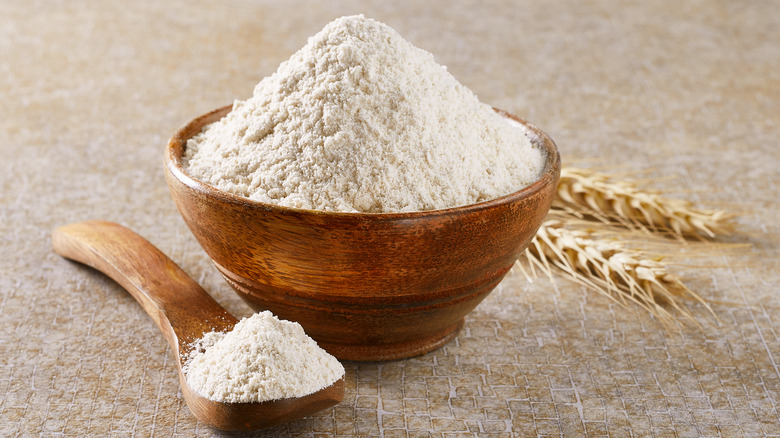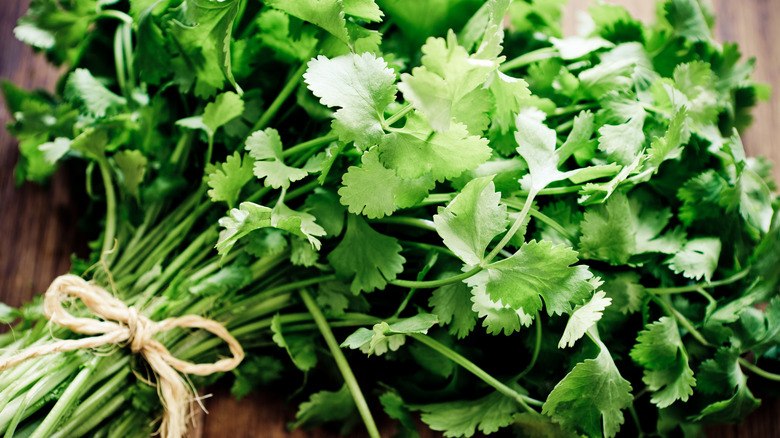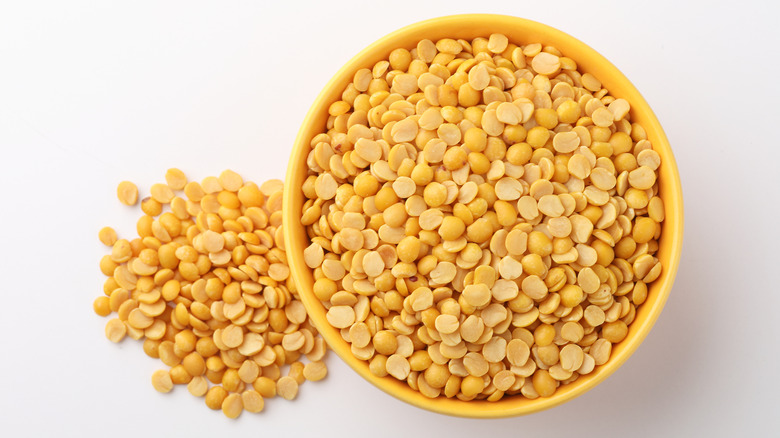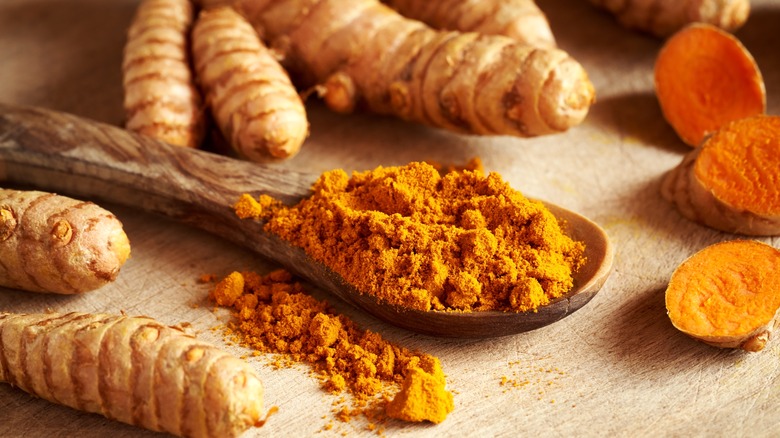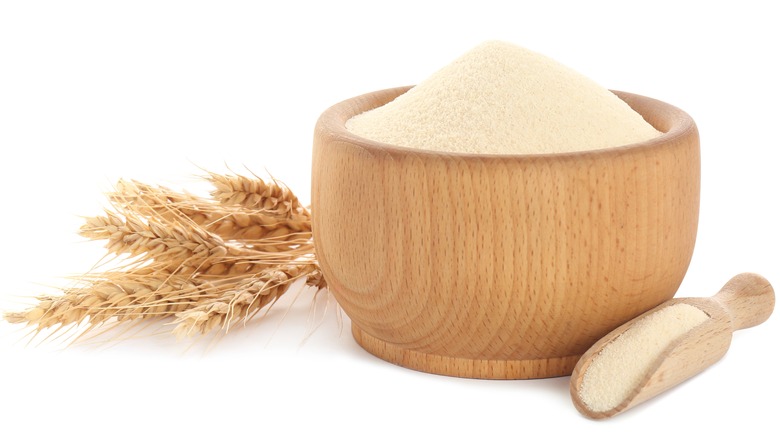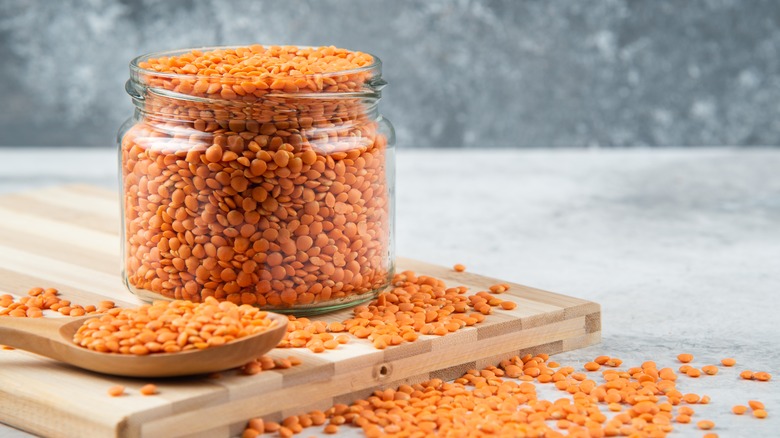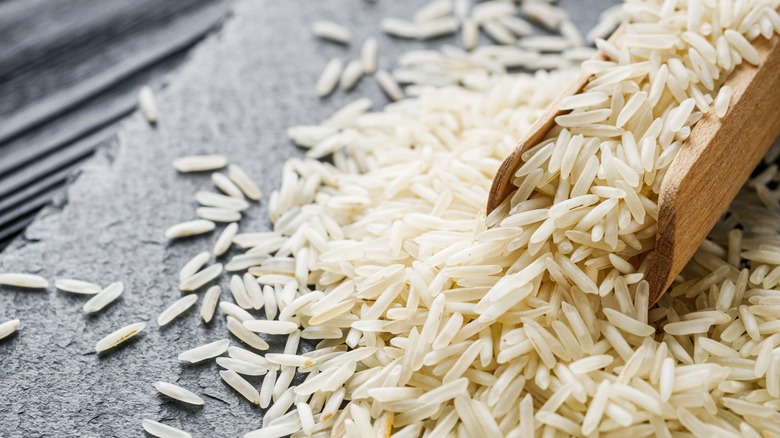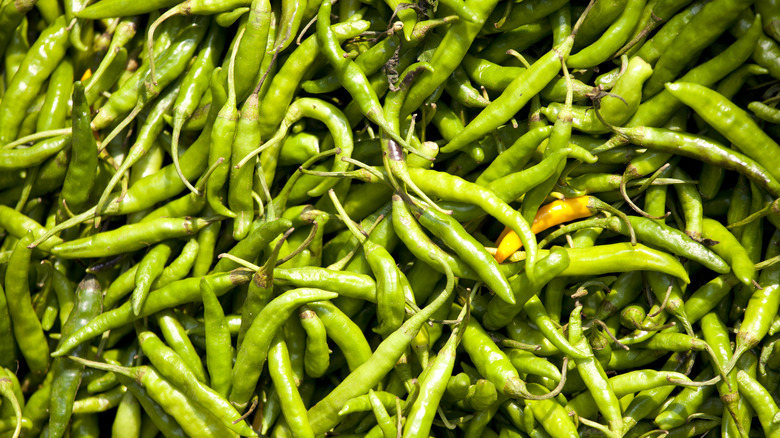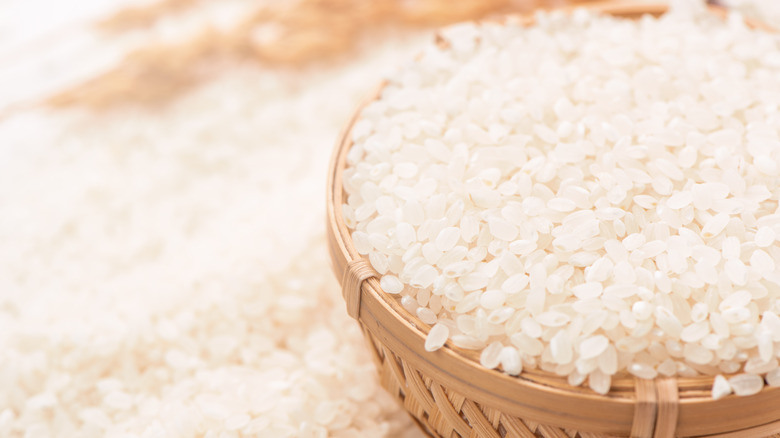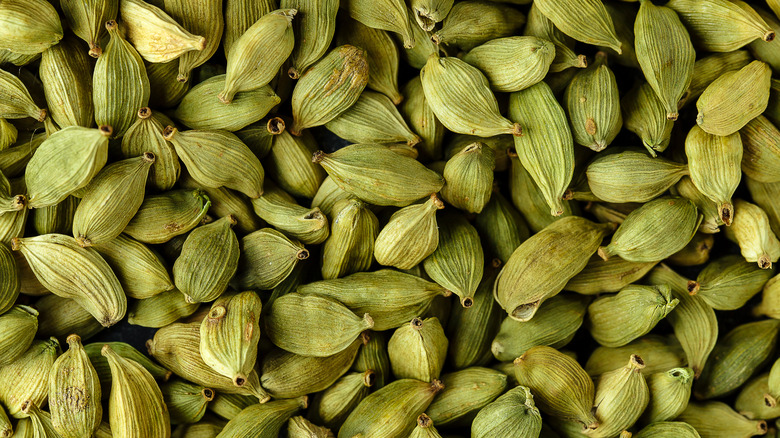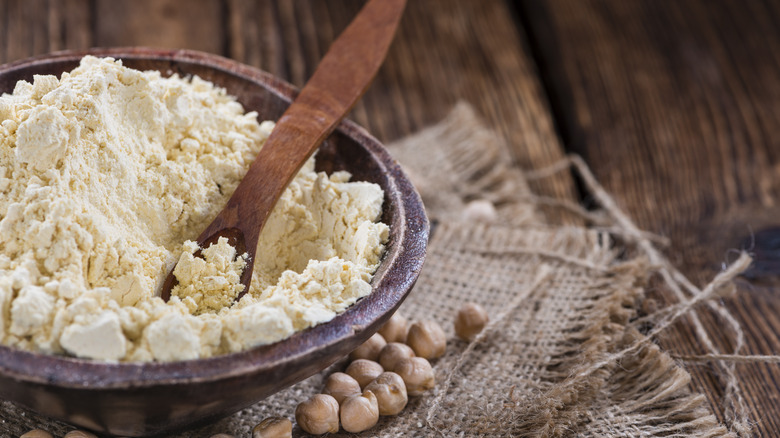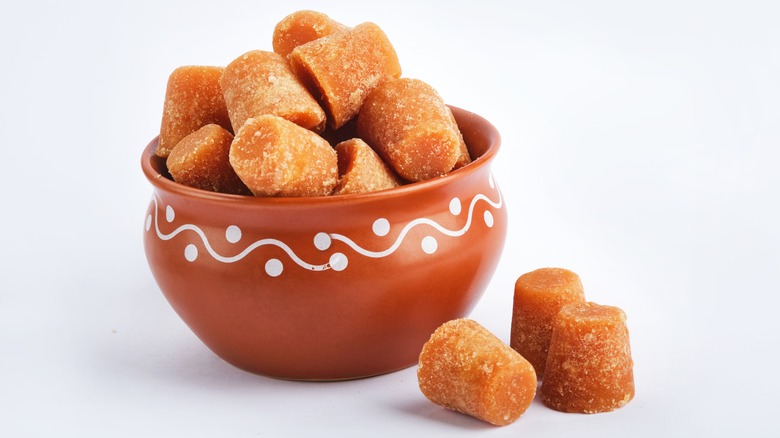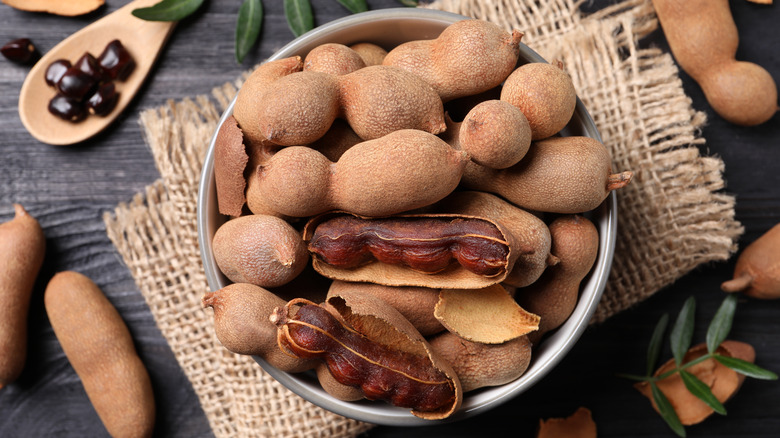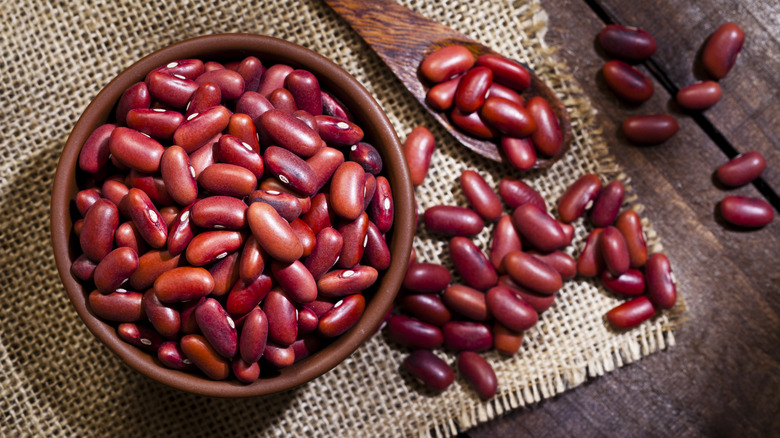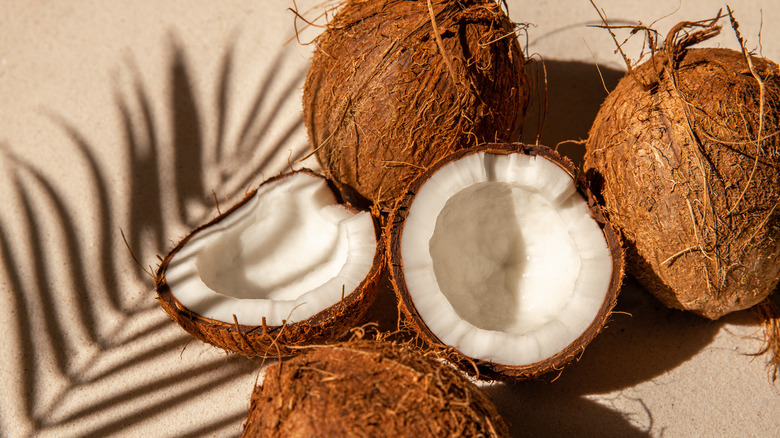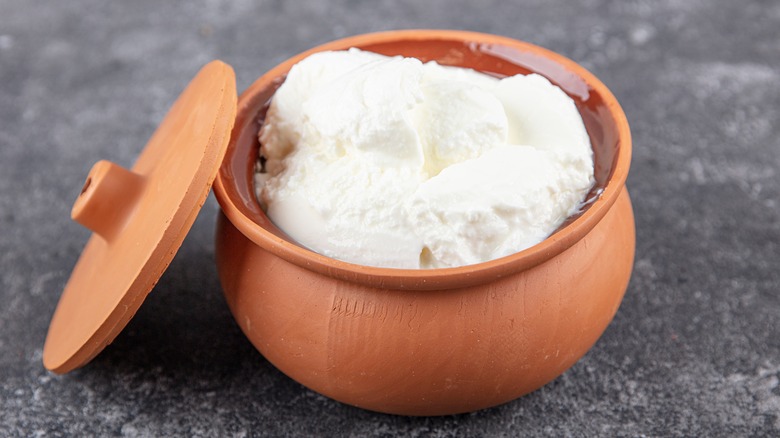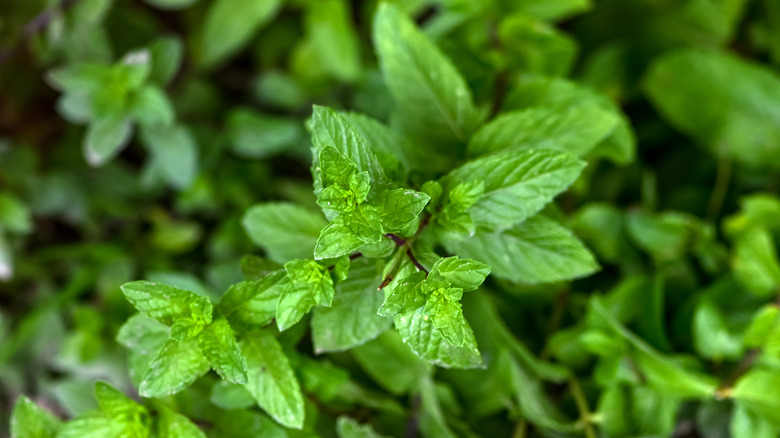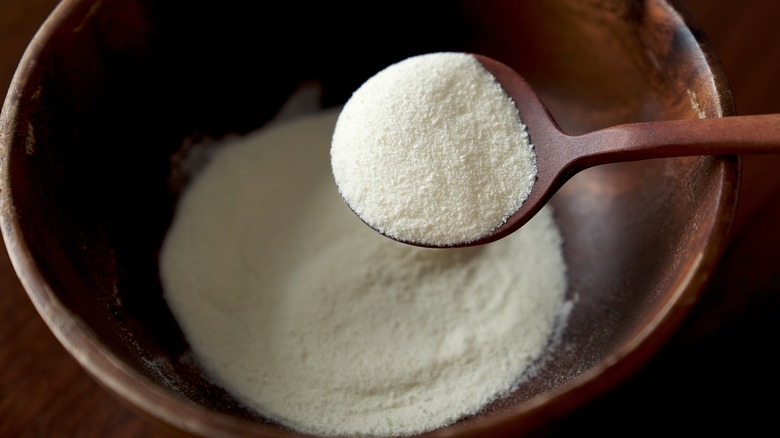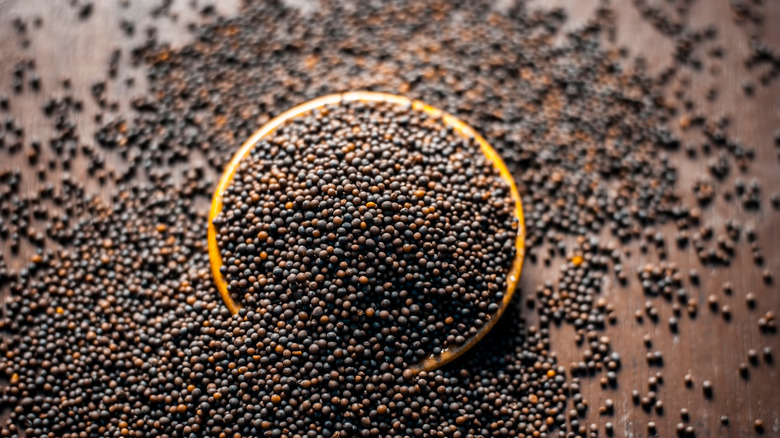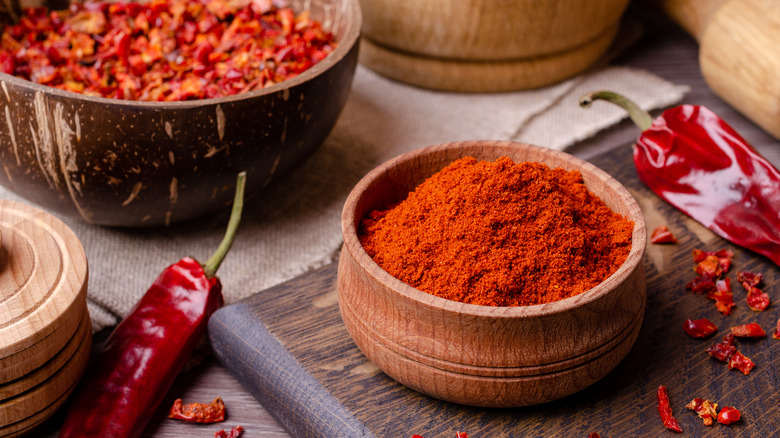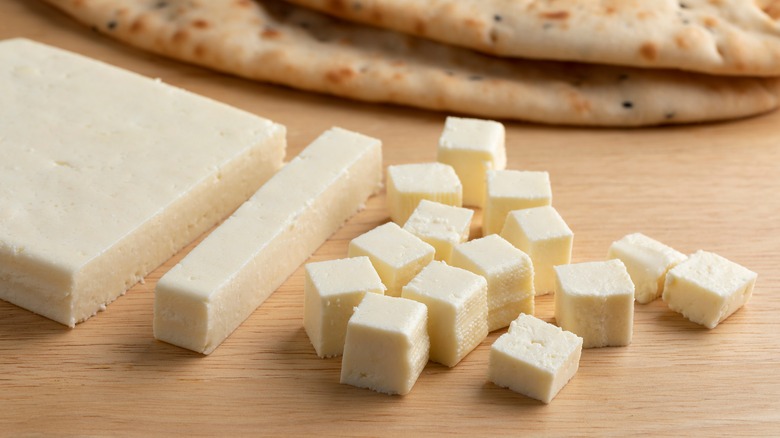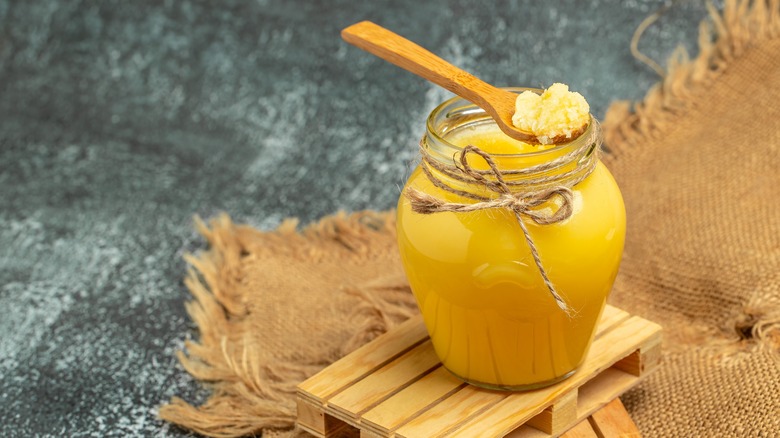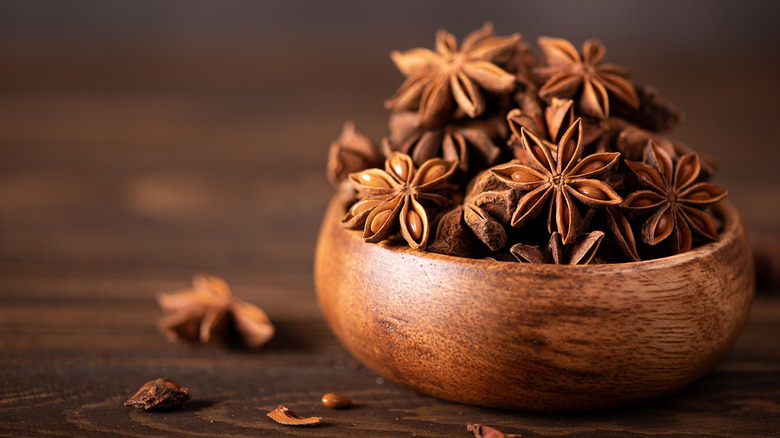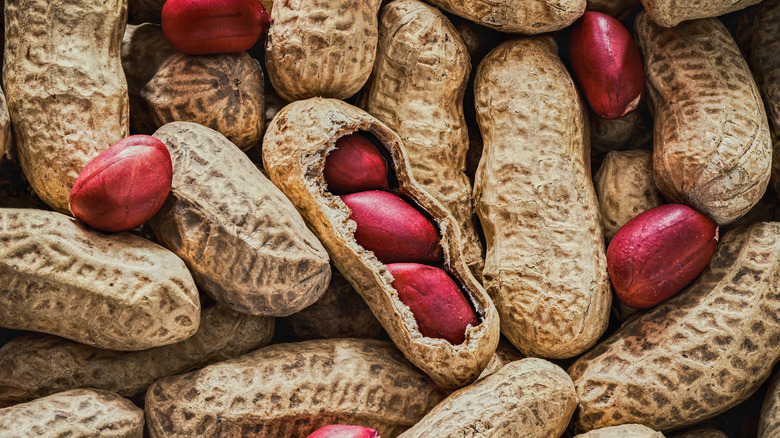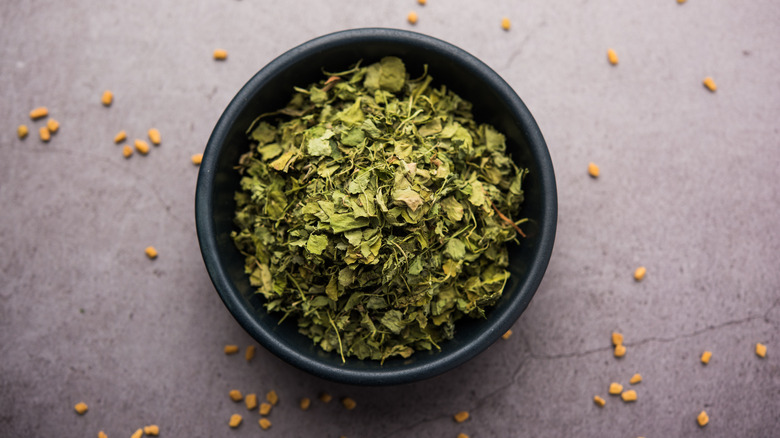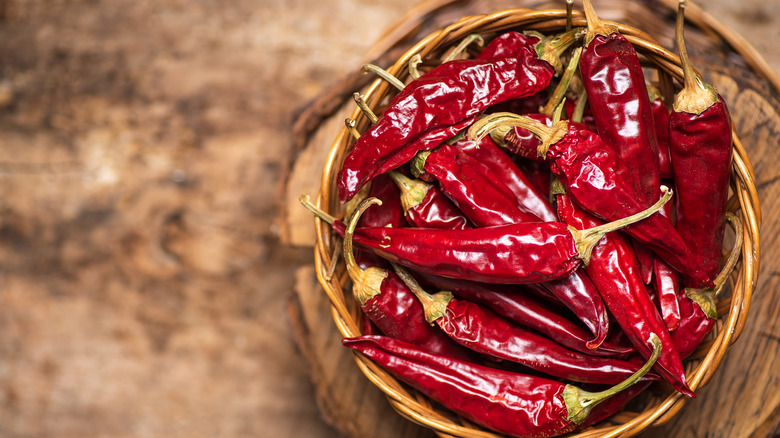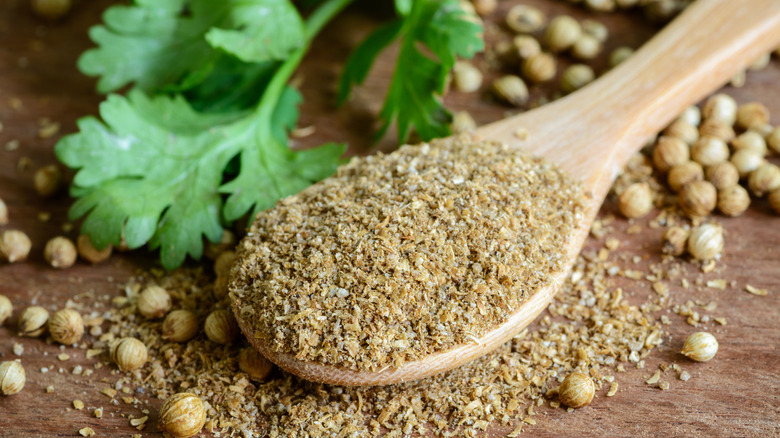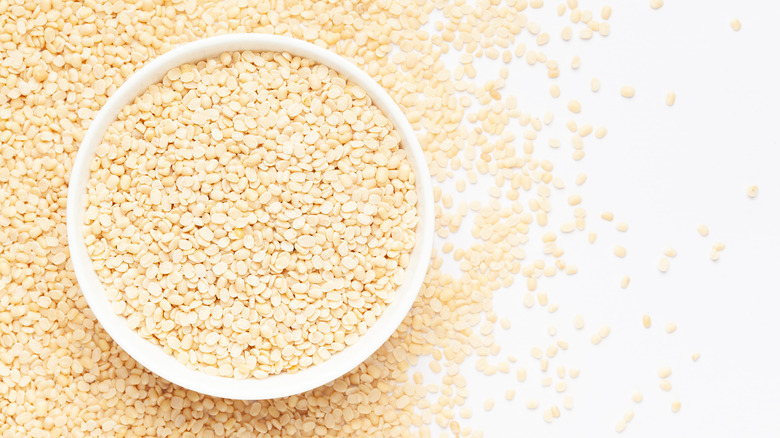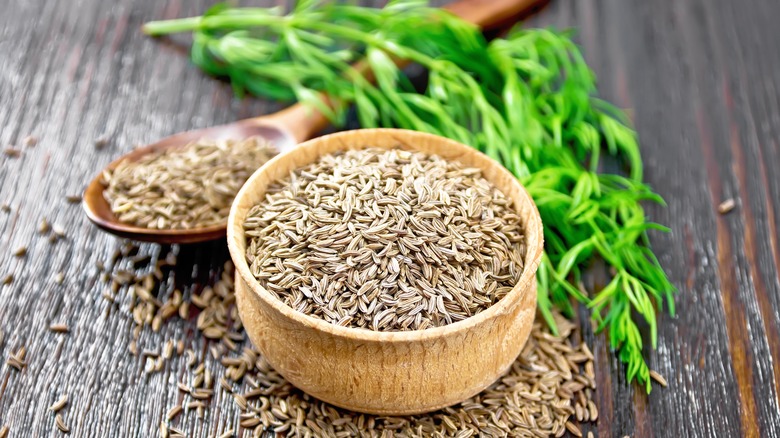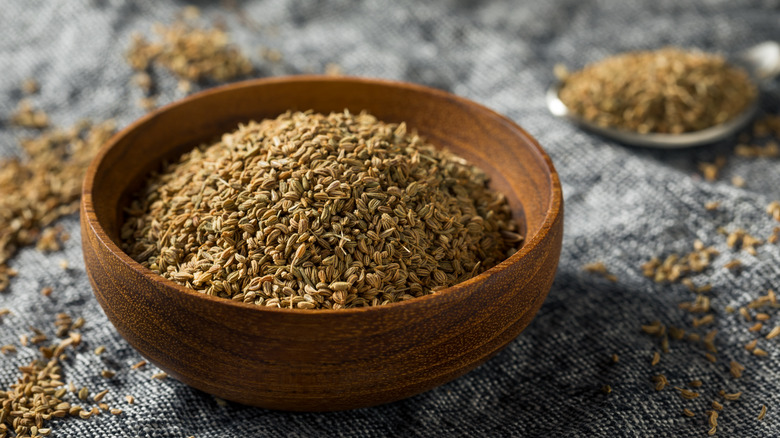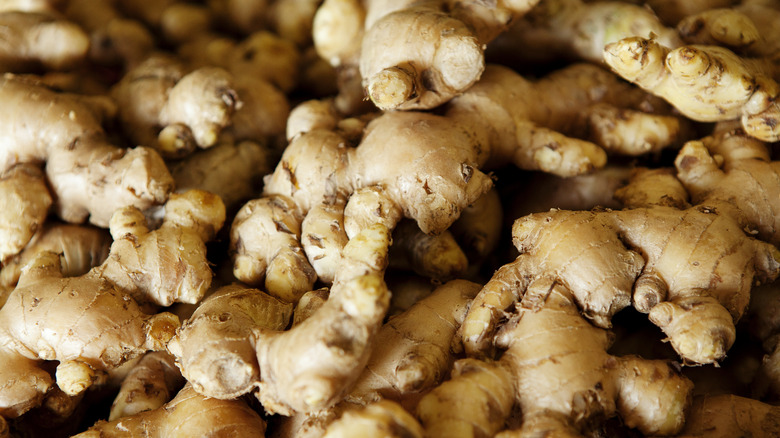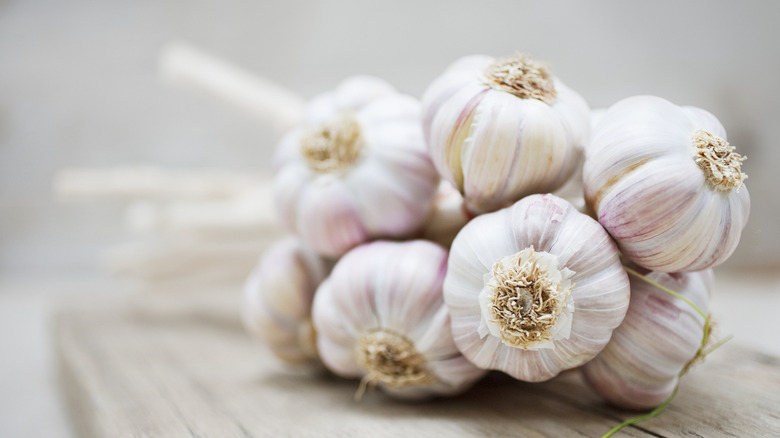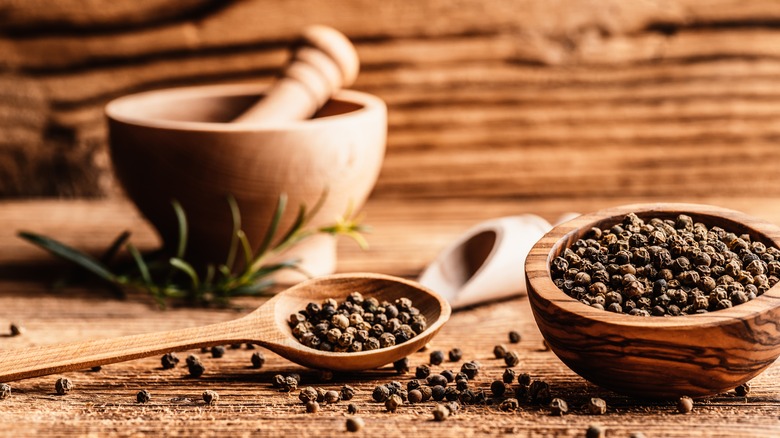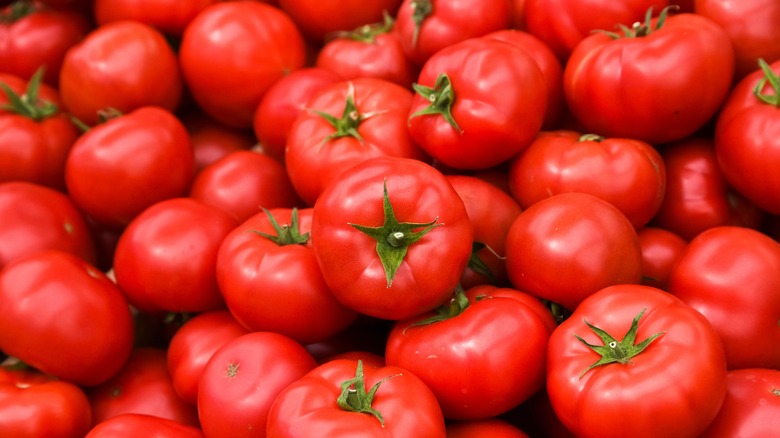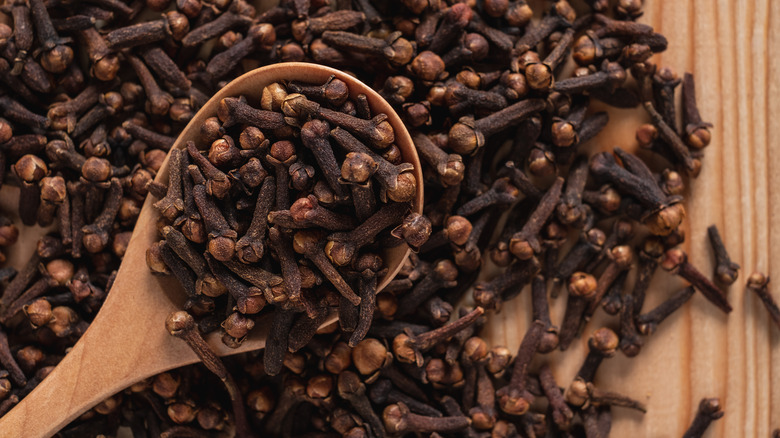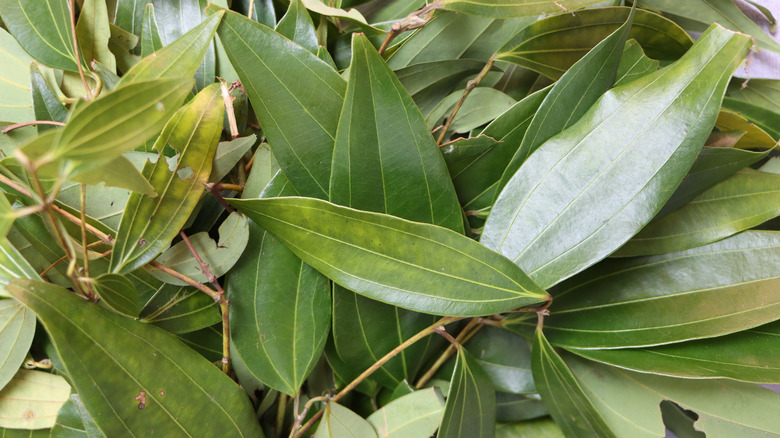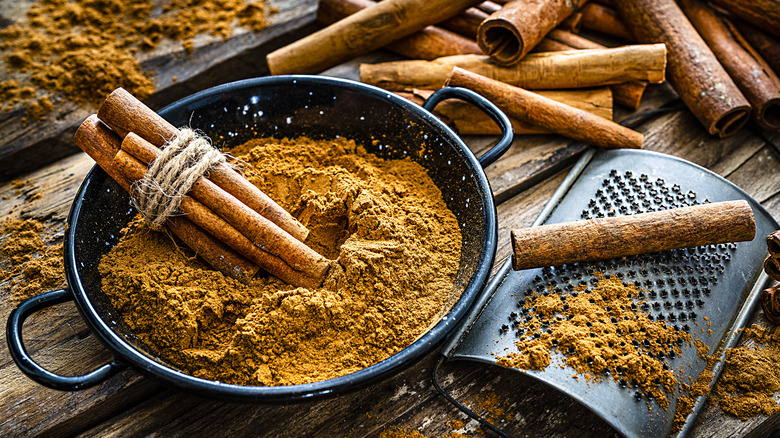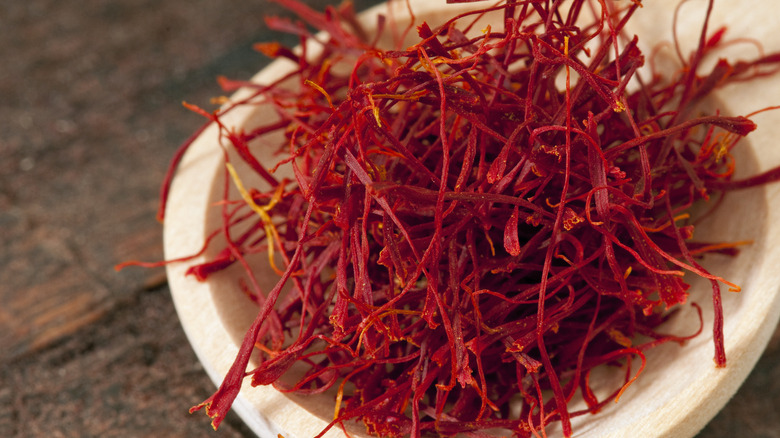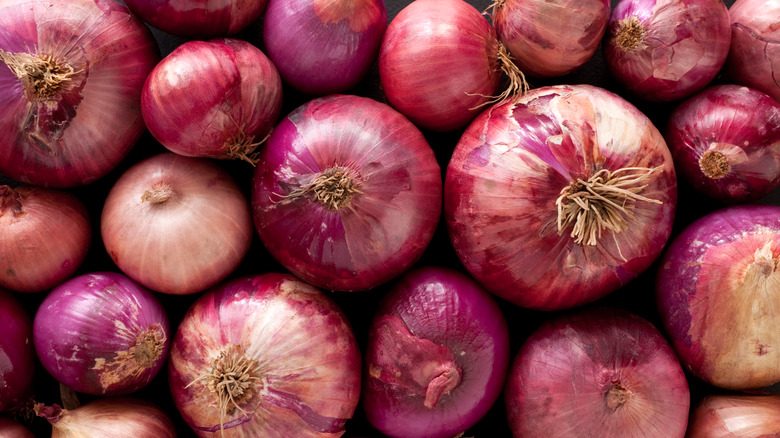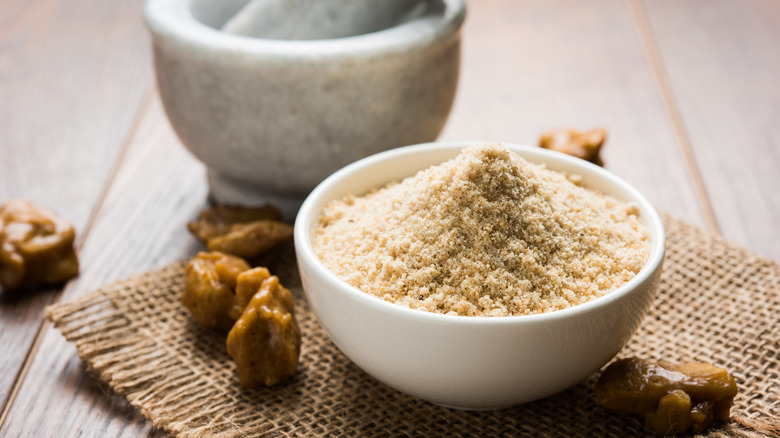42 Essential Ingredients For Indian Cooking
Let's discuss Indian food: It's delicious, it's colorful, it's spicy, and, above all else, it's loaded with an array of earthy, piquant, and aromatic spices that create complex flavor profiles. Soft, pillowy, butter-brushed naan is just waiting to be dipped into the luscious sauces. Crunchy, nutty pakora drizzled with refreshing raita lay alongside succulent tandoor-roasted meats. The question is, how can you create these feasts in the comfort of your own home? How many ingredients are really needed to cover the essentials of Indian cooking?
If you want to build up your recipe repertoire and deliver truly excellent Indian cuisine, you'll need a well-stocked spice cupboard — but there are considerably more ingredients to delve into. Some are obvious (chili peppers, anyone?), while others may not immediately appear necessary but add realms of delight to the final dish.
You may already have several of these ingredients lurking at the back of your pantry. No need to be intimidated and overwhelmed. We promise that building an exhaustive collection of these ingredients is absolutely feasible and will result in the best Indian food as a result of your culinary journey.
Chakki atta (Chapati Flour)
Stone-milled flour — chakki atta in Hindi — is an essential ingredient for Indian bread, including soft and puffy roti, flaky paratha, and crisp puri. You'll soon learn that the key technique for super soft roti lies in an oft-overlooked factor — the flour. Amid all the choices stacking the walls of Indian grocery stores, you only need to focus on one: chakki atta, the perfect flour for making restaurant-style flatbreads to mop up aromatic curries.
While common substitutes like medium atta and wholegrain flour are workable, they're coarser, lacking the delicacy and nutty flavor of chakki atta. Compare it to the difference between all-purpose flour and 00 flour for pizza: It's a game changer.
Fresh coriander
If there's one herb associated with Indian food, it's coriander. Known as cilantro in the U.S. and coriander or dhaniya in India, the vibrant green herb has a bright, citrusy flavor — although a special gene means cilantro tastes like soap to some people.
Fresh coriander is the go-to garnish for all Indian plates, adding a pop of color to the presentation and a hint of tartness. Three-ingredient green chutney traditionally uses fresh coriander as its star component and is the perfect dip to serve alongside papad flatbread, spread over Mumbai's pav bread, or drizzled on top of chaat savory snacks. Make sure to have some in the fridge for your next cooking adventure.
Toor dal (split pigeon peas)
India boasts the largest number of vegetarians with studies suggesting that 24% to 39% of the country's 1.4 billion population abstains from meat. The affordability and impressive nutritious profile of lentils means that India's traditional meals heavily rely on the pulse, with most Indian families eating dal (lentil dishes) daily.
Toor dal is less easily available in the West than other varieties of lentils, but it's worth a trip to your local Indian supermarket. The pulse has a creamy and nutty flavor profile with a robust texture that requires slow cooking. Its versatility and superior taste make it the most coveted lentil in India, commonly used in dal tadka, vegetable sambar, and dhansak.
Turmeric powder
Ah, the spice responsible for numerous stained clothes and countless delicious plates. Turmeric has a remarkable golden hue accountable for the beautiful color of many Indian dishes, but aside from its color, why is it essential for Indian cuisine?
For one, turmeric has been lauded by India's ancient medical system, ayurveda, for centuries. Science agrees, with research showing that the spice holds antioxidant and anti-inflammatory properties. From a purely epicurean point of view, turmeric has uniquely earthy, piquant, peppery undertones. When combined with red chili powder and coriander powder, it forms a trinity of fundamental Indian spices.
Fine semolina
Aside from pasta and European semolina milk pudding, this pale-yellow flour is woefully underutilized in Western gastronomy. Conversely, semolina is a pantry mainstay for all Indian chefs who use the ingredient for sweet and savory treats.
Sooji halwa, a sweet semolina pudding, involves cooking the golden grain with milk, rich ghee, nuts, saffron, and floral cardamon. When roasted with coconut and rolled into round truffles, the semolina transforms into a festive confectionary known as laddu (or ladoo).
However, the coarse grain — made from the hardest of all wheat — is unbelievably versatile. It plays a particularly prevalent role in South Indian cuisine, serving as the foundation for the spice-laced Indian breakfast named upma, a crisp and lacey variety of dosa, and instant fluffy idli.
Masoor dal (red lentils)
Perhaps the most accessible of all pulses, masoor dal — translated as "red lentils" — is the perfect solution for busy weekday dinners. Unlike other pulses, these lentils don't need to be pre-soaked, pressure-cooked, or slow-cooked. After less than 30 minutes, the masoor dal will have cooked down and completely melted into a thick sauce, perfect for seasoning with fresh chilis, ground spices, and zesty cilantro. As the easiest Indian dal to perfect, it's an ideal choice for beginners and perfect to have on hand so you can whip up a quick and tasty side dish on demand.
Basmati rice
Few meals beat the heady aromatic spices, marinated proteins, and fluffy, separated grains of rice that make up biryani. Even its less fancy cousin, pulao, is a sight to behold, with each grain holding more sweetness, earthiness, and spiciness than you can imagine.
So, what's the secret to making restaurant-style biryani at home? Basmati rice is crucial for biryani thanks to two factors: It's a long-grain rice, meaning it possesses beautifully lengthy and separated grains and, crucially, has a desirable toasty aroma.
As aforementioned, basmati isn't just good for biryani; it's great steamed and served alongside creamy curries. If you've got a sweet tooth, simmer the rice in a sweet cardamon and saffron-infused milk to make a time-honored dessert, chawal ki kheer.
Fresh green chilis
It's no secret that chilis play a huge role in the moreish spiciness of Indian food. But, if you've only been using dried chili powder, you're not capitalizing on the unique flavors each variety and form of chili brings. While chili powder aids in creating a uniform layer of heat, freshly chopped chilis provide sporadic hits of firey pungency and won't change the color of your food.
Typically, Indian cooks prefer to use fresh green chilis — specifically, a variety by the moniker "jwala" — which scores 20,000 to 30,000 on the Scoville scale. Although that may sound intimidating, that's on the lower end, around the same level as popular serrano peppers.
Ambemohar rice
Many eager food enthusiasts make the mistake of not exploring the diverse array of Indian rice varieties on offer. Yes, basmati remains the archetypal choice for some recipes, but many more await discovery. Generally, it's good practice to include one long-grain rice in your pantry (where basmati shines) and then one short-grain rice, namely ambemohar, which translates from Marathi to mean "mango blossom," due to its glorious scent.
The buttery flavor and floral fragrance are even more delightful than basmati — and ambemohar boasts versatility, too. Ambemohar is an ideal choice for sour tamarind rice, tangy lemon rice, creamy coconut rice, cooling curd rice, or even spicy bisi bele bath.
Green cardamon
Few spices possess the rare versatility of green cardamon. The little, olive-green colored pods have herbal, floral, and faintly sweet subtleties that lend themselves equally well to savory dishes as sugary desserts. When gently sautéed in fat and then simmered in a rich sauce, the crushed pods implant their warmth into the nuances of the meal. However, when the seeds are removed from the pods and ground in a mortar and pestle, a sprinkle of the powder is surprisingly forceful, although it blends delightfully with flavors of ghee, nuts, saffron, and nutmeg.
Chickpea flour
Chickpea flour (besan in Hindi or garbanzo bean flour in the U.S.) is a must-have ingredient for those interested in Indian cuisine. It's a tremendous all-rounder, capable of making breakfast, lunch, and even dessert recipes. As the name implies, grinding chickpeas into fine flour creates the product, resulting in a nutty aroma and earthy flavor. It's also gluten-free and higher in plant-based proteins and fiber than traditional wheat-based flour.
Use chickpea flour to make a variety of classic Indian dishes, including a wheat-free savory breakfast crepe, vegan besan cheela, tangy Punjabi kadhi with crispy air fryer pakoras, spongy and fluffy steamed dhokla, or sweet and fudgy besan burfi.
Jaggery
Western recipes typically use refined white sugar or, on rare occasions, molasses-rich brown sugar. Otherwise, Indian dishes typically utilize jaggery, an unrefined sugar normally made from sugarcane or date palm sap. So, what's the difference between jaggery and cane sugar? Cane sugar is an umbrella term encompassing unrefined sugar (such as jaggery), as well as raw sugar and refined white sugar that we're all familiar with. Because jaggery is less processed, it retains more nutritious qualities than white sugar, and the appearance is distinct; it's dark in color due to the molasses and is sold in solid blocks.
You can use jaggery as a direct substitute for sugar in traditional Indian desserts and to balance the flavor of curries or dal with a sprinkling of freshly grated jaggery to bring sweetness.
Tamarind
While we typically associate Indian food with spice, to make restaurant-quality Indian food at home, you need to balance flavors. That means investing in ingredients that provide sweetness, saltiness, bitterness, sourness, and umami. Adding tamarind to Indian dishes is an age-old method to infuse your cooking with extra sourness, although the fruit also brings subtle sweetness.
Commonly found in South Indian recipes, tamarind is a favorite addition to lentil dal or fiery, salty, and broth-like rasam. In chutney form, tamarind is a vital component of the famous street food chaat — although any dish is guaranteed to be improved with a drizzle of tamarind chutney.
Kidney beans
Canned foods are some of the most convenient items to stock up on for rainy days. In particular, canned beans are labor-saving. Although kidney beans can be purchased dried, soaking them is a lengthy process, while the canned variety can be used instantly.
Why should you have a stack of canned kidney beans in your pantry? Well, one of the most popular Indian dishes is made with kidney beans. Can you guess what it is? The quintessential North Indian lunch, rajma masala, has kidney beans at its core. They offer a comforting, hearty, and robust flavor that compliments the mildly creamy sauce and fragrant spices.
Coconut
When imaging using coconut in recipes, you probably think of Thai cuisine. However, coastal India — notably the Western and Southern regions — is renowned for using the ingredient. Traditional Indian gastronomy uses three main types of coconut: fresh coconut, coconut milk, or dried coconut. Each has a specific usage, and each is invaluable.
Fresh coconut is used grated as a garnish or cut into large pieces, roasted over an open flame, and puréed into a richly nutty sauce. On the other hand, coconut milk can be added to lentils or curries, acting as a thickener, spice soother, and flavor enhancer. It's typically found in South Indian fish, vegetable and lentil dishes, and chicken curries. Dried coconut, the most accessible of all the options, is excellent for desserts.
Yogurt
Any Indian feast is incomplete without a bowl of raita, a refreshing yogurt-based dip mixed with earthy cumin and grated cucumber (or other vegetables). Whether dolloped on the side of your plate or used to dip your papad or pakora into, it's a must-have.
However, yogurt can just as easily be the star of the show. From tangy kadhi to chilled curd rice and crispy chaat, it's irreplaceable. And once all the mains, sides, and rice dishes are finished, how could we forget our favorite Indian drink, cool mango lassi?
Fresh mint
Alongside fresh coriander, mint might be the second-most used herb in Indian kitchens. The subtlely sweet notes combined with its cooling effect make the herb the perfect companion to pungent Indian eats. While fresh coriander is typically paired with curries, mint finds its companion in bread and rice dishes. Pudina paratha, a flaky layered bread, is a must-try alongside succulent Indian curries. Also, mint-infused rice is gorgeously fragrant.
Furthermore, mint's freshness on the palate lends itself to drinks. Lemon and mint sherbert is an in-demand summer cooler, while the spicy and nourishing properties of a jal jeera drink are always a hit.
Milk powder
The complex, aromatic flavors of Indian main dishes are so enthralling that we often forget there's more to the cuisine than curries and rice dishes. If you haven't experimented with Indian desserts, a whole new world is waiting to be discovered — and you may already have one of the most frequently used ingredients hiding in your cupboards.
Milk powder is the main ingredient for perhaps the most famous Indian dessert: gulab jamun, sweet donuts soaked in a cardamon-scented sugar syrup. That's not all; buttery milk barfi, soft kalakand milk cake, and creamy peda are also made easily by using milk powder.
Black Mustard Seeds
We've all squirted yellow mustard over our hotdogs or paired wholegrain French mustard with cheese, but do you have whole black mustard seeds in your spice cabinet? Indian food may not be the first cuisine you associate with the pungent, bitter spice, but they are exceedingly common in pickles, curries, and lentil dishes.
Black mustard seeds are generally considered the hottest of all mustard varieties, but when fried in oil, their pungency mellows to a sweet, mildly nutty bite. Often paired with cumin seeds, the spice forms the fundamental basic flavor of Indian pickles and is featured heavily in West and South Indian regional cuisine.
Red chili powder
We're betting that the first spice that comes to mind when you envision Indian food is red chili powder. For clarity, in this context, chili powder doesn't refer to the blend used for Mexican food. Instead, it's made from dried red chilis — sometimes just one variety, although often a combination — ground into a fine powder. There are no other ingredients involved.
Of course, red chili powder is a requisite when cooking Indian food. Even if you can't handle the heat, just a small pinch will help to elevate those flavors. If you head to your local Indian shop, many options are available, including the milder, vibrant, and fruity Kashmiri chili powder or the eye-watering ghost chili powder.
Paneer
India doesn't have a booming cheese culture like in Europe or the U.S. Be that as it may, there is one cheese beloved countrywide: paneer. This rustic cheese is made by boiling milk, separating the curds from the whey, then straining and pressing the curds. Once set, the cheese has a bouncy texture and a mild, creamy taste. On account of its straightforward preparation, many Indian households make vegetarian cheese fresh daily, although it's also available to purchase in Indian grocery stores.
Paneer is unique due to its high melting point, meaning it will develop a beautiful golden crust when fried. Due to this attribute, it's a popular choice for curries, including palak paneer and matar paneer. The relatively mild flavor means it's also compatible with sweet desserts.
Ghee
Most savory dishes start with one significant decision: Which cooking fat should you use? While neutral oil is often the safe bet, other choices markedly influence the final flavor of your dish. Across India, numerous cooking fats are used, often depending on region and seasonality. However, one is favored throughout all regions and communities: ghee, a sumptuous, buttery, and nutty variety of clarified butter.
Cooking with ghee builds on the rich complexity of flavor found in Indian curries, rice dishes, and desserts. It also has one of the highest smoke points of all fats, making it ideal for deep-frying and flash-frying.
Star anise
Say hello to the most attractive spice on the block: star anise. These pretty little stars are dried seed pods from the fruit of a tree native to East Asia and command a strong licorice flavor comparable to aniseed — a similarly named yet distinct spice. Much like other aromatic spices, star anise shines when slowly simmered in decadent sauces alongside other fragrant seasonings.
It's not just a pretty face, either. Both traditional Asian medicine and modern Western studies show that anise spice has compounds capable of boosting antimicrobial, antiviral, antifungal, and anti-inflammatory properties. Now, if that's not a good reason to stock up, we don't know what is!
Peanuts
If you've got a packet of peanuts in your cupboard, raise your hand. If that packet is relegated to the back of our pantries or consumed in a snacking fervor, raise your hand. It's time for that to change because peanuts deserve to shine — and we're not talking about peanut butter — but in Indian cuisine, they can.
Peanuts — technically a legume — are rich in healthy fats and protein. You'll most commonly find the roasted nuts in Maharashtrian recipes: stir-fried whole in kanda poha, ground and used to stuff eggplant in bharli vangi, or mixed with tapioca pearls and potato in crispy sabudana vada.
Fresh curry leaves
You're not likely to find a bunch of fresh curry leaves at your local grocery store. This aromatic herb is a specialist ingredient you'll need to seek out online or from your neighborhood South Asian grocer, but we promise it's worth it. Curry leaves are unassociated with curry powder (not a traditional Indian ingredient) and grow on large trees native to India. The herb, when harvested, boasts a punchy citrusy flavor comparable to lemongrass and adds complexity to any dish.
If you're a fan of South Indian food, curry leaves are a basic necessity. They're most commonly tempered in oil with other spices and poured over dishes at the last minute or gently left to simmer and impart their characteristic flavors.
Kasuri methi (dried fenugreek leaves)
In contrast to other world cuisines, Indian gastronomy does not extensively use dry forms of herbs. However, fenugreek is an exception. Perhaps even more widely used than fresh fenugreek, the dried herb is known as kasuri methi in Hindi. Often sold in small boxes or packets, the ingredient commands a distinctively sweet, grassy scent.
While dried fenugreek isn't often the main ingredient in Indian dishes, it's often the difference between an average dish and an exceptional one. Rub the dried herbs between your hands to release their aroma, and add during the last few minutes of cooking to ensure the seasoning remains vibrant. Its characteristic taste pairs especially well with smoky tikka marinades.
Dried red chilis
Dried red chilis are valuable to have on hand for one particular Indian cooking method known for adding depths of flavor to spices: tadka. Also known as tempering in English, it involves heating fat until smoking, then adding whole spices to the hot oil. When poured over the dish, the tempering imbues it with an extra layer of complexity. Dried red chilis are often preferred to chili powder, as they're less likely to burn and become bitter.
There are many varieties of dried red chilis to test. Kashmiri chilis are the most widespread, thanks to their relative mildness, depth of flavor, and bright red color. If you're ambitious, you can grind the dried chilis into a fresh chili powder — it'll taste much better than buying it from the store.
Coriander powder
Do you know that Indian culinarians utilize the entirety of the coriander plant? That's right; the roots, stems, leaves, and seeds are all put to good use. Although it's easy to recognize the vivid green leaves garnishing bowls of curry, there's more coriander in your food than you may realize. Coriander powder, made from roasted and ground coriander seeds, is vital to achieving mellow lemony, earthy notes in your dishes. It's often matched with cumin powder.
Urad dal (black lentils)
Lentils have many more uses than you can imagine. Urad dal has two forms: whole, with a black outer covering, and split, with a creamy off-white color. The latter is a must-have for any cook passionate about Indian food. You can soak and grind the lentils, then fry them to make fluffy, spongy medu vada, or dunk them in yogurt for dahi vada. When mixed with rice and fermented, urad dal forms the basis of South Indian breakfast classic masala dosa, uttapam, and idli. Alternatively, chefs can use the lentils as a stuffing for crispy fritters or temper them in oil to top chutneys, curries, and rice.
Cumin seeds
Just like many other spices, people use cumin in both whole and powdered form. When you stock your pantry, we usually recommend choosing the whole spice, as you can easily roast and grind the seeds at home to create a powdered version when necessary. Cumin seeds hold universal appeal throughout South Asia and each regional cuisine incorporates them in various ways. Most curries and rice dishes start by tempering cumin seeds in oil to impart their sweet, warming notes into the recipe. Because cumin seeds are so tiny, they scatter throughout the meal, scenting each bite with savory nuttiness.
Ajwain
We're all about the snacks and bread here. Who can get enough of either one? And besides, the main dishes don't taste nearly as good without something extra on the side. Ajwain isn't ordinarily used in the centerpiece dishes, but it does feature heavily in Indian snacks. Notably, pakora batter benefits from a sprinkling of fragrant thyme-scented ajwain, and several Indian doughs, including homemade buttery samosa dough, traditionally involve adding ajwain. The nuanced, sophisticated flavors from this tiny seed aren't food in any other element, making it an essential pantry staple.
Ginger
Fresh ginger brings a uniquely warming fieriness to a myriad of dishes, taking the spotlight in Indian cuisine. Unlike the more peppery dried and powdered ginger, fresh ginger can be prepared in many ways, each affecting its final flavor. For instance, homemade ginger garlic paste is a mainstay in the refridgerator of any Indian household, dispersing the spicy kick all throughout a dish. On the contray, finely sliced ginger is an ideal garnish for succulent and oily meat dishes, delivering a crisp texture and fiery piquancy.
Garlic
We admit it. We're guilty of using almost 10 garlic cloves instead of three like the recipe indicated. But, can you blame us? Garlic is an absolute powerhouse ingredient, providing pungency when raw (as in chutneys) and a mellow, buttery sweetness when slow-cooked in curries. It's no surprise that the aromatic bulb is essential for Indian gastronomy, with the ancient aryuvedic system recognizing its medicinal properties and complex tastes. Most savory dishes start by sautéing crushed, minced, or puréed garlic alongside onion and ginger, forming a gorgeously sweet base for fiery spices to build upon later.
Black peppercorns
We all know that Indian food is spicy. But, what does that mean? While it's true that chilis are responsible for most of the dry heat in Indian dishes, there's another spice at play: black peppercorns. Before Portuguese traders brought chilis to India in the 1500s, Indian cooks relied on other compounds to achieve the tongue-tingling fiery punchiness. That spice was black peppercorns, still used in South Indian rasam, biryani, and many spice blends — most notably, garam masala.
Ultimately, it's unfair to compare black pepper and chili peppers. Even though we now have a range of chilis at our disposal, black peppercorns have a unique and indispensable flavor of their own: sharp, woody, fruitiness that comes with a hint of heat.
Fresh tomatoes
When Portuguese explorers brought tomatoes by shipload to India in the early 16th century, they could have never imagined the impact it would have on South Asian cuisine. Centuries later, India abounds with moreish recipes capitalizing on tangy, sweet savouriness of cooked tomatoes. Almost all Punjabi dishes — and a wide number of other regional recipes, including famed classics such as butter chicken and pav bhaji — begin with a base of reduced, caramelized, jammy tomatoes.
You'll find the fruit invaluable, not simply for supplying a deep umami flavor, but also thickening velvety sauces and adding a striking red color to tempting bowls. Fresh tomatoes are best, as canned often add a touch too much acidity.
Cloves
Although they may not look it, cloves are dried flower buds. Despite lacking floral notes, it comes as no surprise that this tiny spice carries a subtle sweetness, offset by an almost undetectable bitterness to create a perfectly balanced aromatic essence. Expect to find cloves used in conjunction with other Indian spices, such as cinnamon, cardamom, bay leaves, and star anise. It's a magic combination that creates irresistibly scented rice dishes, curries, and warming masala chai.
Indian bay leaf
Cooking a soup or casserole involves using bay leaves. But, did you know that there are different types of bay leaves? The same herb you use in your European recipes tastes substantially different from the leaves simmering away in a tempting chana masala. One of a select group of essential aromatic spices, Indian bay leaves are larger and have three characteristic veins running down their length. Almost exclusively used in spice blends, the beginning stages of curry, and to scent rice dishes, Indian bay leaves have an unmissable aroma of muted cinnamon.
Cinnamon
It's unbelievable that bark from a tree can taste incredible, but there's no doubt cinnamon is the king of all aromatic spices. The spice, obtained from peeling, layering, rolling, and drying the inner bark of cinnamon trees, is an essential ingredient in many Indian spice blends, in addition to boasting an important role in rich curries, fragrant masala chai, and lavish desserts.
For the best results, chase down Ceylon (or true) cinnamon as opposed to cassia bark, despite its higher price point. Ceylon cinnamon has a much sweeter flavor profile and has more health benefits to its name, too.
Garam masala
There are countless distinct spice blends in Indian cuisine, including regional and dish-specific mixes. Nevertheless, the most prevalent by a long shot is garam masala, which literally translates to "hot spices." Due to its widespread demand, there are many interpretations of homemade garam masala, but all will incorporate beautifully toasted aromatic spices.
Garam masala is a finishing spice — it's added to the dish within the last minutes of cooking. Since the spices have already been roasted, further frying the garam masala will dull its aroma. The blend complements rich and creamy curries exquisitely, and a slight trace lifts any dish to new heights. Use it in moderation; a little goes a long way.
Saffron
How could we not include the world's most expensive spice, saffron? After their conquest of India, historians suspect ancient Persians brought the luxurious flower to South Asia, starting a centuries-long love affair with its delicate honeyed flavor. In the modern age, saffron is used by Indian chefs to flavor richly spiced dishes such as biryani, royal shahi paneer, and pulao rice. However, its perfumed floral tones really shine when coupled with desserts. Examples include rasmalai with its saffron-infused sweetened milk, creamy nut-laced yogurt shrikhand, or the Indian version of ice cream, kulfi.
Saffron is costly — so it's vital to know how to tell the difference between real and fake saffron. Buy a small packet, and it'll go a long way.
Red onions
While the main protein, lentil, or vegetable used in cooking Indian curries is interchangeable, the base of these succulent and flavorsome dishes usually involves a few repeat characters. Red onions are almost guaranteed to find a place in your cooking, as they provide a sweet caramelized savory taste and add to the thick body of the sauce. We recommend hunting down small red onions for Indian recipes due to their peppery overtones. Additionally, it's customary to serve raw onion alongside your meals in India. Red onion is considered the best choice — not only for its attractive color but also its crisp bite.
Asafoetida
If there was an award for the stinkiest spice, we know exactly which would win. Asafoetida is a staple Indian spice that you should have in your pantry, but have you heard of it before? The powder is somewhat obscure in the Western hemisphere, but you can pick it up in small tubs from your local Indian grocery market. (Tip: Buy asafoetida mixed with turmeric — it's not so smelly.) Made from dried resin harvested from a celery-like herb called ferula, it's beloved across India for its ability to impart a distinctively onion-garlic flavor.
Static Media owns and operates Tasting Table and The Daily Meal.
